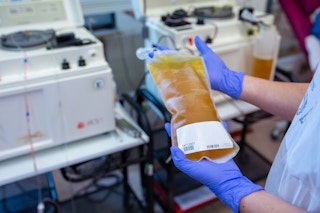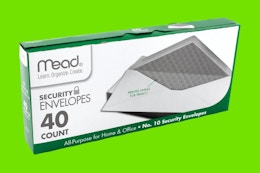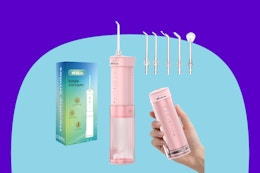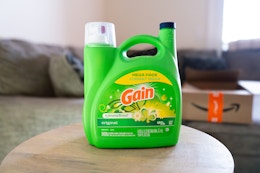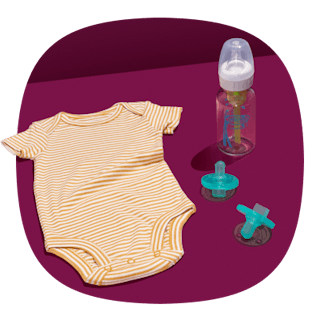Most of us have donated blood at least once in our lives (unless you were the one in the high school gym with a needle phobia). And maybe you’re considering donating plasma. Crucial to the health of immunocompromised patients with life-threatening conditions, plasma is incredibly sought-after by hospitals and blood centers. So much so that many offer a monetary incentive to donate. We’ll tell you how to make money donating plasma.
If you’re overall healthy, weigh over 110 pounds, and are between 18 and 65 years of age, you can find out more information about plasma donation. This includes how much you can actually make. It’s food for thought during these hard financial times, plus the warm fuzzies knowing you are also doing good.
Download The Krazy Coupon Lady app for lifestyle ideas, plus money-saving tips, deals, and coupons.
Tag:section
You can make money donating plasma.
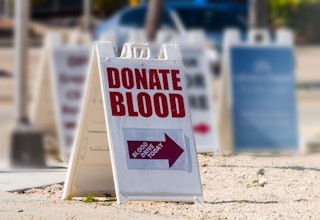
Plasma donors can, in fact, make money by donating. It often appeals to college students who don’t have the time to commit to a full-time job while putting themselves through school. However, it may also pique the interest of anyone looking to improve their financial situation, no matter what that looks like for them. Before you rush over to the nearest plasma donation center, do a little research and get some questions answered first.
Related: 9 Simple & Awesome Ways to Make Money on the Side
Plasma is essential in the body’s effort to heal.

According to the Hospital for Special Surgery (HSS), plasma and, subsequently, platelets are both crucial in the body’s ability to heal. Plasma carries electrolytes to our muscles, supports cell function, and helps the blood properly clot. Additionally, it manages blood pressure and blood volume.
Tag:section
Approximately 55% of our blood is plasma.
Essentially, plasma is the liquid portion of blood. According to the American Red Cross, “About 55 percent of our blood is plasma and the remaining 45 percent are red blood cells, white blood cells, and platelets that are suspended in the plasma.”
Plasma itself is mostly made up of water. However, it’s the vital proteins it contains, like albumin, gamma globulin, and anti-hemophilic factor, plus minerals, hormones, fats, and vitamins, that make it so coveted in the medical industry. This is especially true in the wake of the coronavirus pandemic.
Plasma donations can be frozen for an entire year.
Once donated, plasma can be frozen for up to one year — another big benefit. It’s given to patients of trauma, burn, and shock. But wait, it doesn’t stop there. Plasma donations also benefit those with liver disease, immune deficiencies, clotting deficiencies, and other bleeding disorders.
Since plasma is so critical to overall health and immunity, donation centers want your plasma (and your blood!). Seriously, they need it. In fact, 2022 saw the U.S. Department of Health & Human Services launch the Giving = Living campaign. This is an attempt to encourage more people to donate.
But we’d be remiss to ignore another significant incentive, too, and that’s the money.
Money for plasma donation starts at $20 and goes up from there.

How much money you can make from donating plasma depends on a few different factors. These include where you live, how much you weigh, how much usable plasma is extracted, and how often you donate.
Some plasma centers offer $100 per donation (no matter how much you weigh) for the first couple of sessions if you’re a new donor. But the prices vary by location and are, of course, subject to change. Anecdotally, people report making as little as $20 to $50 per plasma donation. However, with the emergency state of things and the high demand for plasma, it’s likely higher.
Tag:section
Others report making as much as $500 in their first month of donating plasma, but it’s true that the more you go, the more you can make.
Donors who weigh more (but under 400 lbs) tend to get paid more.
The Food and Drug Administration (FDA) sets the guidelines around plasma donations. Currently, donors have to weigh at least 110 pounds for consideration. Those who weigh more likely have an opportunity to be paid more. That being said, plasma centers may turn away any donor more than 400 pounds due to health concerns.
“Opposite, you get paid more (the more you weigh),” one TikTok user writes. “I read somewhere that 400+lbs may not be able to donate. Otherwise you can give/be paid more the heavier you are.”
Donors are also eligible for bonuses, which is why how much you can make donating plasma varies greatly. At some centers, you can score an additional $100 bonus just for donating eight times in one month!
Some of the highest paying plasma donation centers include:
- CSL Plasma ($20 – $100)
- BioLife Plasma (between $30 – $40, but now offering a $900 bonus for new donors)
- Interstate Blood Bank (up to $50)
- Grifols ($30 – $100)
- Immunotek (up to $50)
While Octapharma Plasma only lists a monthly incentive (up to $400/mo), there is no official word on how much they pay per donation. Their website does advertise that new plasma donors can earn up to $800 in their first 35 days!
Plasma donation should only feel an initial pinch.

Experiences vary person to person depending on several factors, including personal pain tolerance. WebMD strongly maintains that donating plasma shouldn’t be painful. In fact, it shouldn’t feel that different from a standard blood donation.
Many donors only cite the initial pinch of the needle (same as when donating blood) as the “most painful” part. Others report a mild sting post-needle. Other than that, it should be comfortable.
Plus, in addition to getting paid, there’s all the snacks you can eat and juice you can drink at the end.
Plasma donors must be between the ages of 18 and 65.
To qualify for donating plasma, you must be between the ages of 18 and 65. Furthermore, you must weigh between 110 and 400 pounds and be in overall good health.
Before donating, you will have to complete a medical history screening and test negative for any virus that can be passed via blood (ie. hepatitis or HIV). If you test negative and pass the screening, you’re good to go.
According to DonatingPlasma.org, it’s recommended that donors eat a high protein diet of 50 to 80 grams of protein per day. Donors should also fully hydrate before going to a session.
Those who can’t donate plasma include anyone under 110 pounds or above 400 pounds. Additionally, if you fail the medical screening, test positive for viruses, and/or aren’t of age, it’s a no-go.
Anyone who has had a recent surgery, gotten a tattoo or piercing within the past year, and/or is currently taking certain medications for a medical condition may not be able to donate.
Donating plasma frequently can help you earn some extra cash.

While figuring out if donating plasma for money is worth it, you’ll have to take all of the aforementioned factors into consideration.
For some people, it’s a great option. Donating frequently can help you pay off some debt, get through school, or just have a little extra cash on hand. Another plus? There’s usually no waiting period to get your coin. At most plasma centers, you receive a prepaid card with your money on it. So it’s ready to use immediately.
Perhaps the most important factor to consider is your personal health. Decide how that translates to how much you can donate. Does your weight make it worth the money? How much time can you dedicate to donating? If the average plasma donation takes anywhere from 40 minutes to an hour and a half, consider whether it’s a viable option.
If you have blood type AB, your plasma is in high demand.
For people with the blood type AB, you’re a part of what’s known colloquially as the AB Elite. That’s because AB blood is rare. Only an estimated four percent of Americans have this blood type. As such, the demand for AB plasma is extremely high. Moreover, it’s the only type of plasma that can be given to patients of any blood type.
AB plasma donations can be made every 28 days, up to 13 times per year.
The most common recommendation centers adhere to is you can donate plasma as often as every 28 days. However, you can (theoretically) donate as many as two to three times a week. After all, plasma takes 24 to 48 hours to regenerate; wait a minimum of 24 hours between donations.
But the FDA put the kibosh on that, so theoretical is all it is. The FDA requires at least seven days between plasma donations. That means once a week is the most you can donate.
Download the KCL app to add and redeem coupons in store

